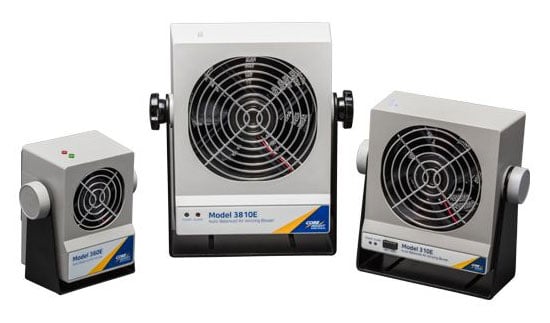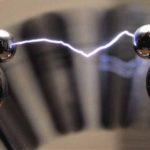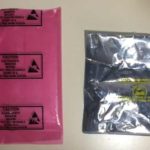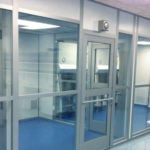Static charge must be controlled in today’s electronics manufacturing environments. Without effective control, static charge will cause electrostatic discharge (ESD) to components as well as electrostatic attraction (ESA) of particles to critical product surfaces. Static control programs start with grounding. Everything that is conductive or static dissipative must be connected to ground. However, in most manufacturing areas there are conductive items that cannot be connected to ground, and items that are insulators. Grounding will not remove the static charge from insulators.
Bipolar Ionizers
When isolated conductors or insulators are present in the manufacturing process, static charge can only be neutralized by the use of bipolar ionization. Bipolar ionizers create positive and negative charges in the gases in the air. These positive and negative “ions” in the air can neutralize the static charge on any surface they contact. Having both polarities assures that charge of either polarity on an insulator or isolated conductor will be effectively neutralized. But effective neutralization also requires that the amount of positive and negative ions must be kept in balance.
Unbalanced Ionizers
Unbalanced ionizers can actually create static charge on ungrounded objects. The net effect of ionizer imbalance on an object is measured in volts. Creating charge on an object is the opposite of what you are trying to do with ionization. The ESD sensitivity of today’s complex electronic components is often less than 250 volts and there are components with an ESD sensitivity as low as one volt. Protecting these ESD-sensitive components will require a means of assuring ionizer balance.
Electric Ionizers
Electronic (corona) ionizers have various means to adjust ionizer balance, both manual and automatic. Manual adjustments are used to set the balance initially but require frequent readjustment or calibration due to voltage changes, emitter point erosion, emitter cleanliness, and environmental changes. This means that long-term stability of ionizer balance is only achievable with frequent maintenance. Ultimately, maintenance costs will exceed the costs of the ionizers.
Automatic adjustment of ionizer balance can be achieved through the use of sensor feedback. This involves the use of internal or external sensors to monitor and adjust the operation of the ionizers. Based on information from the sensors, the ionizer power supplies can be adjusted to maintain ionizer balance. Internal sensors only monitor the ionizer output and cannot correct for environmental influences such as nearby grounds or airflow. External sensors mounted in the work area can adjust the ionizer to maintain balance for both electronic and environmental issues. This results in less maintenance and an improvement in the long-term stability of the ionizer.
Unfortunately, both methods of feedback require a significant number of additional parts that can increase the cost of the ionizer, particularly if it must achieve extremely low balance voltages, for example, 5 volts or lower. The additional parts and complexity of the feedback systems inevitably result in reduced long-term reliability of the ionizer.
CoreStat® Theory
CoreStat® products made by Core Insight use an intrinsic self-balance method to achieve ionizer balance. It starts with an understanding of the basic physical law, Conservation of Charge. Simply stated, Conservation of Charge requires that in an isolated environment you can neither create nor destroy charge. With respect to ionizers, if you produce ions of one polarity in an isolated environment, you must produce the same number of ions of the opposite polarity. Therefore, the net charge created is zero. This also means that the ionizer balance will be zero. How well this intrinsic self-balance method works depends on the success of isolating the ionization process.
Isolating the Ionization Process
Physical isolation of the ionization process means isolating from ground. The ionizer consists of a bipolar high voltage power supply connected an array of emitter points. These positive and negative emitter points must be physically isolated from any grounded surface and only reference each other. Electronic isolation of the ionization process means that the positive and negative high voltages applied to the emitter points are not referenced to ground. Instead, the reference is to the opposite polarity emitter points. This means that anything affecting the ion output from one polarity emitter point will also affect the opposite polarity. Conservation of charge requires that the ion outputs be equal.
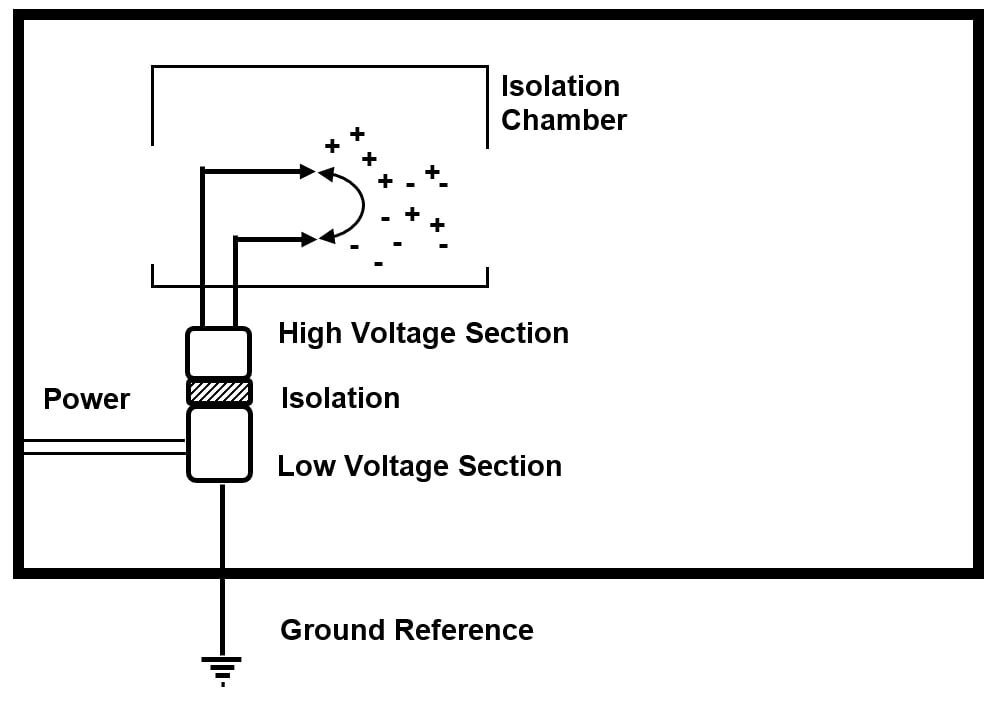
For example, if the ion output for the positive polarity decreases, Conservation of Charge requires that the ionizer power supply adjust to reduce the ion output for the negative polarity as well to maintain balance. Over time the ionizer will remain in balance, but the overall ion output will decrease. This is not a problem as long as the discharge time meets factory requirements. When it does not, ionizer cleaning and maintenance are required. The effect of the CoreStat® technology is a significant decrease in the maintenance required to keep the ionizer in balance and a concurrent increase in the long-term stability of the ionization process. The result is a decrease in both maintenance costs and the possibility of ESD damage to ESD-sensitive components.
CoreStat® Features and Operation
Ionizers incorporate CoreStat® intrinsic self-balance technology to maintain ionizer balance at low levels for long periods of time. This occurs with reduced need for periodic maintenance and results in improved stability of the ionization process. Ionizer maintenance still requires cleaning of the emitter points, but at longer time intervals than with other ionization technologies. An example of a CoreStat® fan-type ionizer is shown in Figure 2. An additional feature of CoreStat® fan-type ionizers can actually eliminate almost all maintenance costs. An automatic emitter point cleaner as shown in Figure 3.
These cleaners require turning the ionizer off until the fan stops, and then turning it back on after a few seconds. The cleaning process only occurs when the fan speed is below its operating level. Also available is an option to have a programmable cleaning cycle that can be set by the user to clean automatically every 24-hour cycle, often when no production is occurring. The combination of CoreStat® self-balance and auto-cleaning can virtually eliminate most ionizer maintenance. This also means there is no loss of production time for ionizer maintenance.
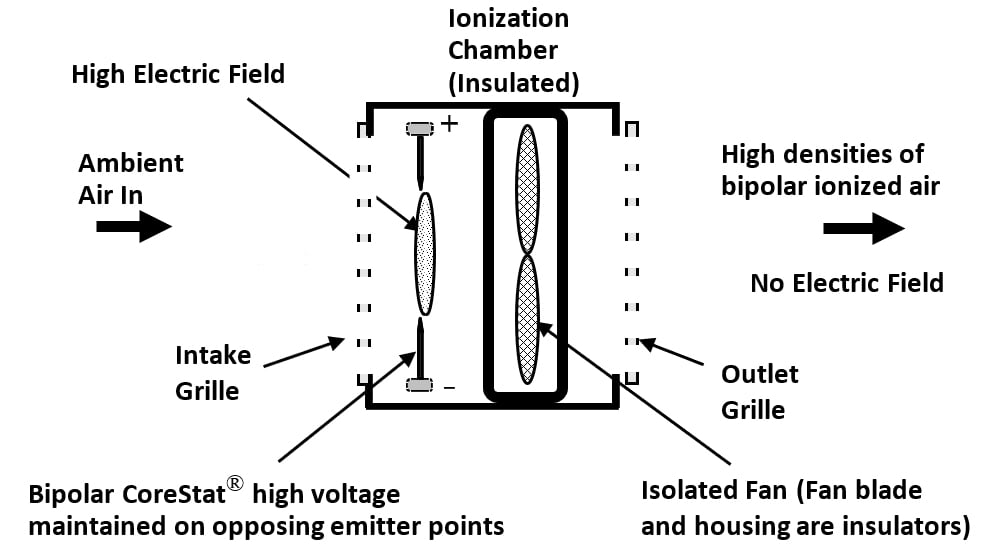

While the cost of ionizer maintenance will be different in each ionizer application, a simple calculation can be made:
- 100 ionizers, 4 emitter points per ionizer, maintenance time 10 minutes per point, labor rate $40 per hour, 4 times per year. Maintenance cost is $10,666.
- Additionally, add the cost of 40 minutes of production downtime, four times per year at each location, while maintenance is performed. Production downtime cost will vary between different facilities, but 2.67 hours per year at each of 100 workstations, at only $40 per hour, will exceed the maintenance cost. Production line downtime will typically exceed $40 per hour by a large amount.
CoreStat® self-balance and auto-cleaning can eliminate all of these costs.
An additional benefit in the operation of CoreStat® ionizers is the reliability that results from the combined self-balance and auto-cleaning features. These features assure that the ionizer is always operating according to factory requirements and protecting ESD-sensitive product from damage. But it is true that electronics does occasionally fail. An additional optional feature of CoreStat® ionizers is a monitoring and alarm system. The ionizer output is monitored and if it no longer meets the stated balance requirement, an alarm signal is generated. Another alarm signal is generated if there is a catastrophic high voltage power failure of the ionizer. These alarm signals guarantee that any ionizer failure will be quickly noticed and the ionizer in question can be cleaned or replaced. The alarm signals are available at a standard RJ-45 Ethernet connector for transmission to facility monitoring systems.
CoreStat® Applications
The feature set available for CoreStat® technology ionizers makes them ideal for many electronics applications. First, and foremost, the extremely low balance voltages coupled with long-term stability makes them ideal for critical applications that require high reliability. This is especially important when electronics manufacturing processes must handle extremely ESD-sensitive devices. Ionizers used in these processes must work 24/7/365 with minimal maintenance and as close as possible to zero incidence of failures. CoreStat® ionizers with self-balance combined with emitter point auto-cleaning and performance alarms meet all the requirements for these critical uses. You can be sure that implementing CoreStat® ionizers in your manufacturing process will eliminate static charge and ESD problems and their impact on production yields.
Workbench Ionizers
CoreStat® technology is often deployed in workbench ionizers to assure that manufacturing operations do not result in static problems. Eliminating charge from process essential insulators and isolated conductors will minimize the possibility of ESD damage and reduce particle attraction to products. Industry standards mandate maximum voltage levels due to static charge on isolated conductors and separation of chargeable insulators from ESD-sensitive product. These recommendations may be difficult to implement for processes occurring on workbenches.
The voltage specification for isolated conductors is not related to conductor size. The basic equation, V = Q/C, tells us that at a given voltage, large capacitance objects will have a higher charge. Just specifying a maximum voltage may not protect devices from these higher charges. Even a screwdriver tip can hold enough charge at a voltage of 35 volts to damage ESD-sensitive products. There is also a large variety of insulators that may be present on a workbench. These may be tools, fixtures, packaging materials, and chemical bottles, among others. Some insulator items may be easy to isolate from the ESD-sensitive product, but others, primarily those in the product itself, cannot be isolated by distance. In workbench situations, CoreStat® technology ionizers will provide the control of static charge needed to eliminate the static problem with less than 5 volts of ionizer imbalance.
CoreStat® and the Interior of Production Equipment
The interior of production equipment is another area where CoreStat® technology ionizers find unique applications. Static charge is typically generated on products as they are handled in automated equipment. This comes from triboelectric charging occurring during pick-and-place operations of components in the equipment. Electronic parts are packaged in insulating materials (epoxy, ceramic, or plastic). When these are transferred by the equipment, charge is generated on the component package. When the leads of the component touch ground, an ESD event can occur. CoreStat® technology ionizers neutralize static charge on products to extremely low levels, below those at which ESD damage occurs. Additionally, CoreStat® self-balance and auto cleaning assure the operation of the ionizer, often in locations that would require disassembly of the equipment and lost production time for maintenance procedures. CoreStat® eliminates the cost of these procedures.
Production equipment is replacing personnel in many manufacturing processes. The need for Human Body Model (HBM) ESD control is becoming less important. Industry groups have noted that the damage to ESD-sensitive devices is primarily a Charged Device Model (CDM) event or a Charged Board Event (CBE). As noted above, CDM occurs when the device package becomes charged by handling. The voltage on the device is determined by the charge and the device capacitance. Once the device is mounted on a circuit board it will have an even larger capacitance, to which are added the capacitances of other devices on the circuit board. Large charges may exist, but voltages can still be low. Protecting devices from CDM or CBE damage requires ionizer balance to very low levels, a feature of CoreStat® ionizers.
Conclusion
As manufacturing process requirements for ESD control to extremely low levels become more widespread, the features of CoreStat® ionization will become increasingly important. Self-balance at low levels (5 volts or lower) assures that static charge will be reduced below the level at which CDM or CBE ESD damage occurs. Auto-cleaning reduces maintenance costs and production downtime and enables applications inside production equipment. Monitoring and alarms assure reliable operation over long periods of time. These features will find increasing importance as the trend to more ESD-sensitive devices continues over time.
Core Insight is revolutionizing ionization for cleanroom environments in the semiconductor, medical device, and technology sectors. While the competition has stagnated, Core Insight has been innovating, bringing better ionization technology to your critical environments.
Core Insight Innovations
- Ion Bars that provide uniform coverage, and 2X the ion density of any other bar on the market
- Ceiling ionization systems that cover a larger area, with faster neutralization and unmatched stability
- Steady State DC Ion Blowers that don’t require regular maintenance or calibration
Related Posts
-
Cleanroom Ionizer Selection Guide
What is the advantage of ionizers for static control and particle cling? How do I select the right ionizer? View the selection guide.
-
Why Do Corona Ionizers Need Regular Maintenance?
What equipment in your manufacturing environment is maintenance free? The answer is simple: none. As with all other equipment, ionizers used for static charge and contamination control need an established maintenance process. Ionizers using corona…
-
Air Ionization: How it works
What is Air Ionization and How Does it Work? Air ionization neutralizes static charge on insulated and isolated objects by producing a balanced source of positively and negatively charged ions. Whatever static charge is present…
-
Is Linoleum Flooring Conductive or Anti-Static?
Genuine linoleum is a 100% biodegradable material composed of linseed oil, pine resin, cork, wood, pigment, and limestone. Depending on material construction, it is known to have antistatic properties which mitigate some triboelectric charges that…
-
What's the Difference Between Anti-Static and Static Shielding Bags?
Standard pink anti-static bags fail to protect ESD-sensitive devices from the flow of electrically charged objects. Learn about the requirements for ESD safe packaging, metal faraday bags, and the differences between anti-static, dissipative, and conductive…
-
Why is Modular Cleanroom Design A Huge Development?
Pre-engineered fabrication consolidates scheduling with minimal disruption and fewer variables. Difficult or expensive upgrades avoid overbearing noise, construction artifacts, and minimize if not eliminate the burden on facility staff for project management.


